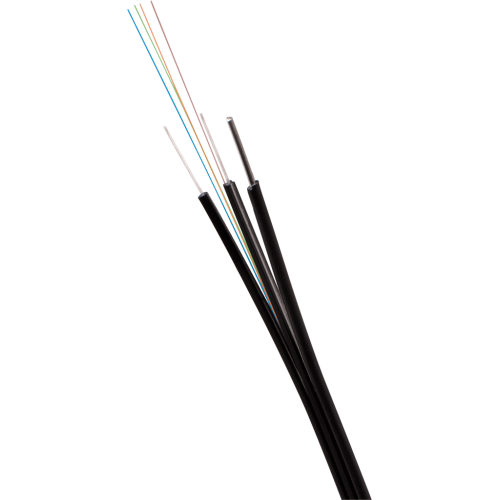Used as a distribution cable for suspension on the utility poles, electricity pylons, between buildings, and for cabling inside buildings, in cable ducts, pipes, also for outdoor cabling along the external facades of buildings. The cable has loose tube (? Or tight tube) optical fibers. FRP rods are used as strength members. Steel wire is used as a messenger. Fibers, the strength members, and the messenger are covered with overall jacket. The cable jacket is made of a flame retardant, halogen-free, low-smoke polymer composition. The cable jacket color is black. The maximum possible count of optical fibers in the cable is 8. Design 
Color identification of tight buffer optical fibers: | № | Fibers 1-8 | | 1 | Blue | | 2 | Orange | | 3 | Green | | 4 | Brown | | 5 | Grey | | 6 | White | | 7 | Red | | 8 | Black | Weight and dimensions Fiber count in the cable | Up to 4 | Up to 8 | Cable dimensions, mm | 2,0 х 5,2 | 2,1 х 5,6 | Cable weight, kg/km | 19,6 | 21,0 | Minimum bend radius, mm | 20 | 21 | Operating conditions Operating Temperature | -50°С…+70°С | Installation Temperature | -10°С…+50°С | Storage Temperature | -50°С…+50°С | Minimum Bend Radius | At least 10 cable diameters | Lifetime | 25 years | Physical specifications Optical cable is resistant to the following impacts Impact type | Nominal value | Criteria for evaluation | Installation pulling tension (IEC 794-1-93 Е1 test procedure) | 730 N | Δα* ≤ 0,05 dB no damage | Crush resistance
(IEC 794-1-9З Е3 test procedure) | 200 N/cm
100 N/cm
(for micro-module design) | Dynamic bending stresses
(IEC 794-1-93 Е6 test procedure) | 20 cycles at an angle ±90° | Axial twisting stresses
(IEC 794-1-93 Е7 test procedure) | 10 cycles at an angle of ± 360 ° at a length of 4 m | Impact (IEC 794-1-93 Е4 test procedure) | Impact energy is 1 J | Climatic impact*
(IEC 794-1-93 F1 test procedure) | Temperature range from
- 50 °С to +70 °С;
2 cycles
cycle duration ≥ 16 hours | Δα ≤ 0,05 dB/km | * - increase in attenuation of an optical fiber in a cable at specific wavelengths. Applicable optical fibers SU | Single-mode fiber with extended operating wavelength and reduced attenuation and low bending loss (ITU G.652D+G.657.A1 recommendation) | S2 | Single-mode fiber with an extended bandwidth of operating wavelengths (ITU-T G.652D recommendation) | S5 | Single-mode positive non-zero dispersion shifted fiber (ITU-T G.655 recommendation) | S7 | Single-mode with low bending loss (ITU-T G.657 recommendation) | M1 | Multi-mode with core to cladding ratio 62,5/125 μm (IEC 60793-2-10 A1b type recommendation) | M2 | Multi-mode with core to cladding ratio 50/125 μm (ITU-T G.651 recommendation and IEC 60793-2-10 type A1a.1 requirements) | M3 | Multi-mode with low bending loss and core to cladding ratio 50/125 μm (ITU-T G.651 recommendation and IEC 60793-2-10 A1a.2 type requirements) | M4 | Single-mode fiber with extended operating wavelength and reduced attenuation and low bending loss (ITU G.652D+G.657.A1 recommendation) | |

